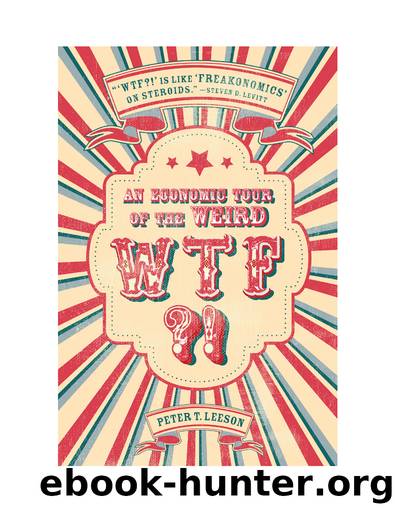WTF?! by Peter T Leeson

Author:Peter T Leeson [Leeson, Peter T.]
Language: eng
Format: epub
Publisher: Stanford University Press
Published: 2017-08-15T00:00:00+00:00
Geographic distribution of vermin trials and heretics, 1450â1700.
[Ania:]
âWhatâs that?â
That, Ania, is a map that depicts vermin trial hot spots and heretic hot spots in early modern continental Europe.
[A portly, mustachioed patron shouts:]
âIt looks like they overlap!â
It sure does, Tuskernini. Let me tell you a bit more about the map. It reflects forty-six cases of bug and rodent trials for which records survive between 1451, when citizens in Berne, Switzerland, sued some rats, and c.1680, when citizens in Chur, Switzerland, and Constance, Germany, sued some worms.55 It excludes one trial of rats in an unknown location in Spain. I suspect this trial was conducted in northern Spain near the border of southwestern France, but I canât be sure. I collected these data from the register of ecclesiastical vermin trials that Edward Payson Evans compiled in his book The Criminal Prosecution and Capital Punishment of Animals.56
Each circle on the map plots the location of one or more early modern vermin trials. The largest circles reflect locations where ecclesiastics conducted three vermin trials, the second-largest circles where they conducted two, and the smallest circles where they conducted one.
The cross-hatched areas reflect approximate regions of known Vaudois concentrations and concentrations of witch trials between 1450 and 1700.57 The former include Dauphiné and Provence, France, and Piedmont, Apulia, and Calabria, Italy.58 The latter include areas in which a dozen or more witch trials were conducted during these years. These are, in France, southern Burgundy, most of Rhône-Alpes, eastern Lorraine, and northwestern and southern Aquitaine; in Italy, Lombardy; and in Switzerland, the cantons of Berne, Vaud, Lucerne, and Neuchâtel. I collected my data on witch trials in France, Italy, and Switzerland from the register of such trials that a fellow named Marc Carlson assembled.59
[The economist interrupts:]
âWhatâs with the witch trial hot spots? I thought we were looking at Waldaises.â
Dr. Spock was undoubtedly tuned out again when I was telling everyone about the history of this âWTF?!â-worthy practice. Who can tell him why witch trial hot spots would be a reasonable proxy for hereticalâin particular, Waldensianâpresence?
[Ania raises her hand.]
âThe Waldenses were equated with witches!â
Thatâs right. The fact that âwitches were often equated explicitly with the Waldensiansâ was unfortunate for the Vaudois.60 But itâs fortunate for me. âThe insistence upon the witchesâ heretical nature often caused witches and heretics to be put on trial together.â61 Thus, together with areas known to be under strong Waldensian influence, I can use areas of intense witch trials to proxy areas of intense heretical, and in pre-Reformation years, in particular Waldensian, influence.
The test my map provides is unavoidably crude. My samples of both kinds of trials are smallâsurely smaller than the actual number in each case. And the witch trial hot spots depicted in my map are based only on trials whose location is known.62 They necessarily exclude witch trials whose date and country are known but whose location within the country isnât. Thus, as with any analysis relying on historical data of this nature, my map must be interpreted with caution.
Furthermore,
Download
This site does not store any files on its server. We only index and link to content provided by other sites. Please contact the content providers to delete copyright contents if any and email us, we'll remove relevant links or contents immediately.
Spell It Out by David Crystal(35811)
Professional Troublemaker by Luvvie Ajayi Jones(29393)
We're Going to Need More Wine by Gabrielle Union(18586)
The Secret History by Donna Tartt(18056)
Cat's cradle by Kurt Vonnegut(14694)
The Goal (Off-Campus #4) by Elle Kennedy(13160)
The Social Justice Warrior Handbook by Lisa De Pasquale(11930)
The Break by Marian Keyes(9052)
Crazy Rich Asians by Kevin Kwan(8846)
Thirteen Reasons Why by Jay Asher(8398)
The remains of the day by Kazuo Ishiguro(8338)
Educated by Tara Westover(7632)
The handmaid's tale by Margaret Atwood(7407)
Win Bigly by Scott Adams(6786)
Giovanni's Room by James Baldwin(6749)
This Is How You Lose Her by Junot Diaz(6401)
The Rosie Project by Graeme Simsion(5792)
Six Wakes by Mur Lafferty(5780)
The Last Black Unicorn by Tiffany Haddish(5386)
